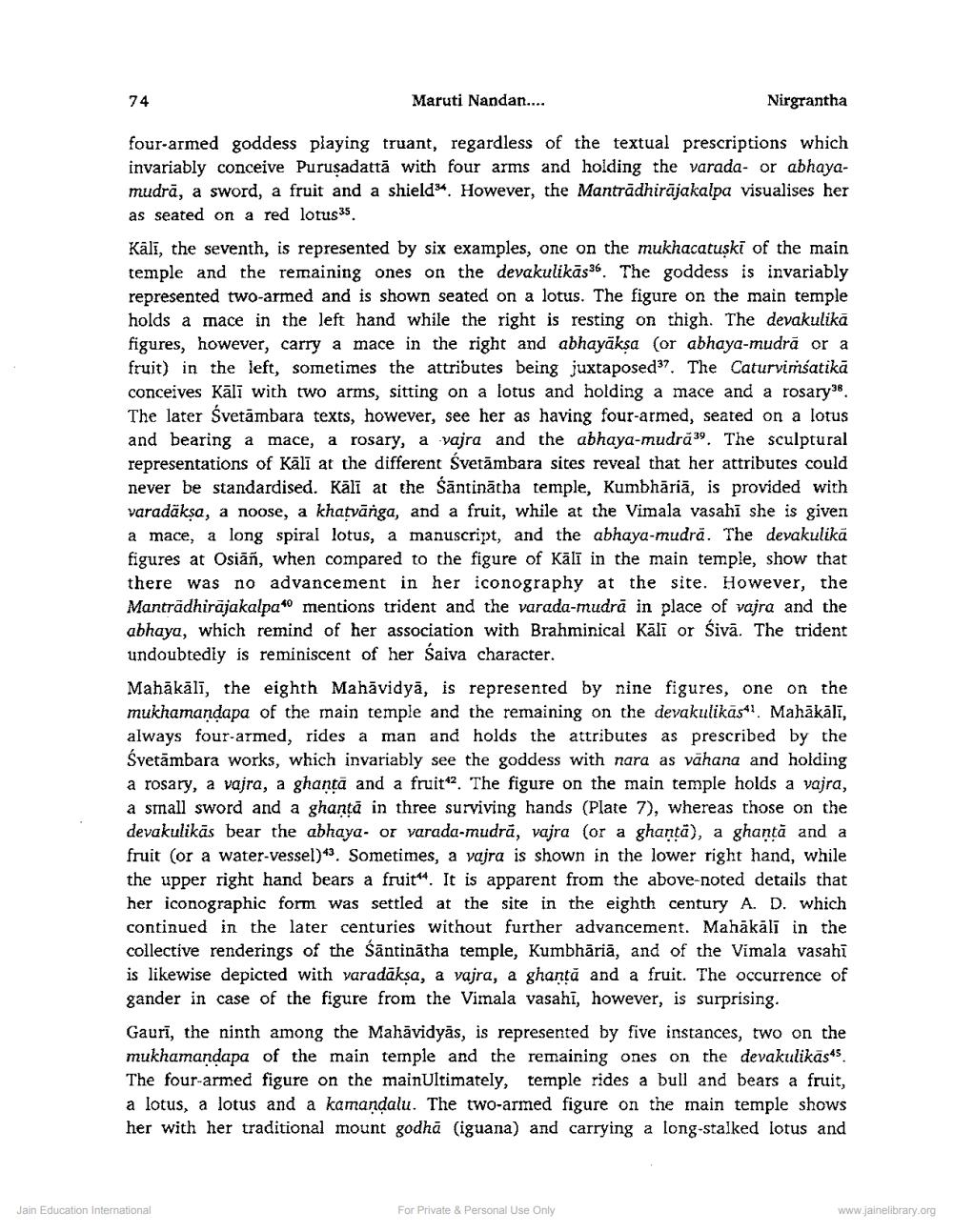Book Title: Jaina Mahavidyas in Osian Author(s): Maruti Nandan Prasad Tiwari, Kamalgiri Publisher: Z_Nirgrantha_1_022701.pdf and Nirgrantha_2_022702.pdf and Nirgrantha_3_022703.pdf View full book textPage 5
________________ 74 Maruti Nandan.... Nirgrantha four-armed goddess playing truant, regardless of the textual prescriptions which invariably conceive Purusadattā with four arms and holding the varada- or abhayamudrā, a sword, a fruit and a shield34. However, the Mantrādhirājakalpa visualises her as seated on a red lotus 35. Kālī, the seventh, is represented by six examples, one on the mukhacatuski of the main temple and the remaining ones on the devakulikās36. The goddess is invariably represented two-armed and is shown seated on a lotus. The figure on the main temple holds a mace in the left hand while the right is resting on thigh. The devakulikā figures, however, carry a mace in the right and abhayāksa (or abhaya-mudrā or a fruit) in the left, sometimes the attributes being juxtaposed37. The Caturvimsatikā conceives Kālī with two arms, sitting on a lotus and holding a mace and a rosary38 The later Svetāmbara texts, however, see her as having four-armed, seated on a lotus and bearing a mace, a rosary, a vajra and the abhaya-mudrā39. The sculptural representations of Kālī at the different Svetāmbara sites reveal that her attributes could never be standardised. Kālī at the Sāntinātha temple, Kumbhāriā, is provided with varadäksa, a noose, a khatvānga, and a fruit, while at the Vimala vasahi she is given a mace, a long spiral lotus, a manuscript, and the abhaya-mudrā. The devakulikā figures at Osian, when compared to the figure of Kālī in the main temple, show that there was no advancement in her iconography at the site. However, the Mantradhirajakalpa" mentions trident and the varada-mudra in place of vajra and the abhaya, which remind of her association with Brahminical Kālī or Śivā. The trident undoubtedly is reminiscent of her Saiva character. Mahākālī, the eighth Mahāvidyā, is represented by nine figures, one on the mukhamandapa of the main temple and the remaining on the devakulikasal. Mahākāli, always four-armed, rides a man and holds the attributes as prescribed by the Svetāmbara works, which invariably see the goddess with nara as vāhana and holding a rosary, a vajra, a ghant, and a fruit. The figure on the main temple holds a vajra, a small sword and a ghantā in three surviving hands (Plate 7), whereas those on the devakulikās bear the abhaya. or varada-mudră, vajra (or a ghanta), a ghantă and a fruit (or a water-vessel)“. Sometimes, a vajra is shown in the lower right hand, while the upper right hand bears a fruit*4. It is apparent from the above-noted details that her iconographic form was settled at the site in the eighth century A. D. which continued in the later centuries without further advancement. Mahākāli in the collective renderings of the Sāntinātha temple, Kumbhāriā, and of the Vimala vasahi is likewise depicted with varadāksa, a vajra, a ghant, and a fruit. The occurrence of gander in case of the figure from the Vimala vasahī, however, is surprising. Gaurī, the ninth among the Mahāvidyās, is represented by five instances, two on the mukhamandapa of the main temple and the remaining ones on the devakulikās4s. The four-armed figure on the mainUltimately, temple rides a bull and bears a fruit, a lotus, a lotus and a kamandalu. The two-armed figure on the main temple shows her with her traditional mount godhā (iguana) and carrying a long-stalked lotus and Jain Education International For Private & Personal Use Only www.jainelibrary.orgPage Navigation
1 ... 3 4 5 6 7 8 9 10 11 12 13 14 15 16 17 18 19 20
